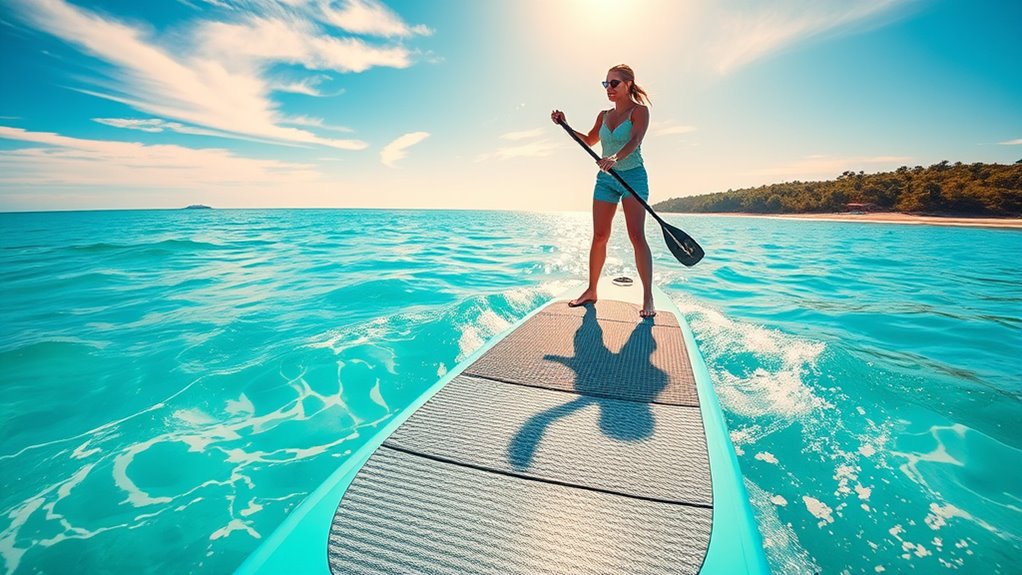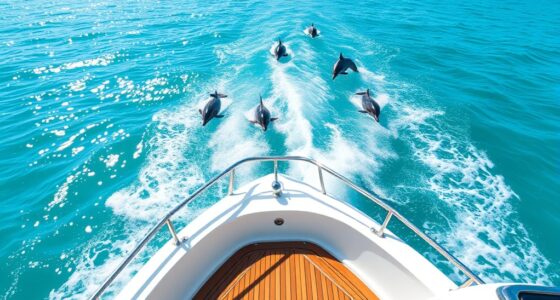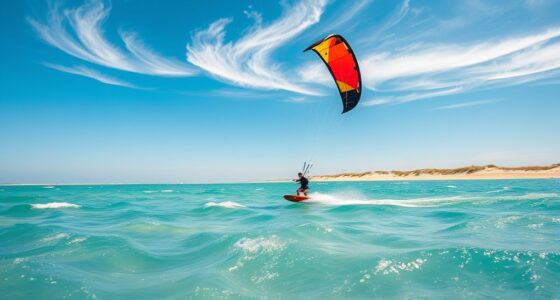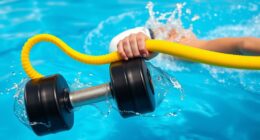To start paddleboarding on the ocean, choose a stable, suitable board based on your skill level and water conditions. Learn to maintain proper balance by keeping a wide stance and engaging your core. Practice paddling steadily on calm days, paying attention to currents and wave patterns. Stay safe by checking tides, weather, and wind forecasts. If you keep exploring, you’ll discover more tips to help you enjoy your paddleboarding adventures even further.
Key Takeaways
- Choose a stable, inflatable paddleboard suitable for beginners and calm ocean conditions.
- Check tide, weather, and wave patterns to select a safe time and location for paddling.
- Practice basic paddling techniques with steady, controlled strokes and maintain a wide, balanced stance.
- Focus on core engagement and mental focus to build confidence and improve stability on the water.
- Always wear safety gear, stay near shore, and monitor ocean conditions throughout your paddleboarding session.
Choosing the Right Paddleboard and Gear

When selecting your paddleboard and gear, it’s essential to contemplate your skill level, the type of water you’ll be paddling in, and your overall goals. Choosing equipment carefully helps ensure stability, ease of use, and safety. For beginners, a wider, inflatable paddleboard offers better balance and portability. If you plan to paddle in calm waters, a more lightweight board may suffice, but for rougher ocean conditions, opt for a sturdy, durable model. Paddleboard maintenance is vital to keep your gear in top shape; rinse your board after each use, check for dings or punctures, and store it properly away from extreme temperatures. Proper care extends your equipment’s lifespan and guarantees a safer, more enjoyable paddleboarding experience. Incorporating regular maintenance practices can also help prevent costly repairs and ensure your equipment performs at its best over time. Additionally, understanding the horsepower of electric dirt bikes can inspire you to explore energy-efficient options for powering your gear or accessories related to your paddleboarding adventures. Being aware of the state tax implications for your location can also help you plan financially for your outdoor pursuits. Utilizing climate control strategies, such as proper insulation and ventilation, can further enhance your gear storage conditions and longevity.
Understanding Ocean Conditions and Safety Measures
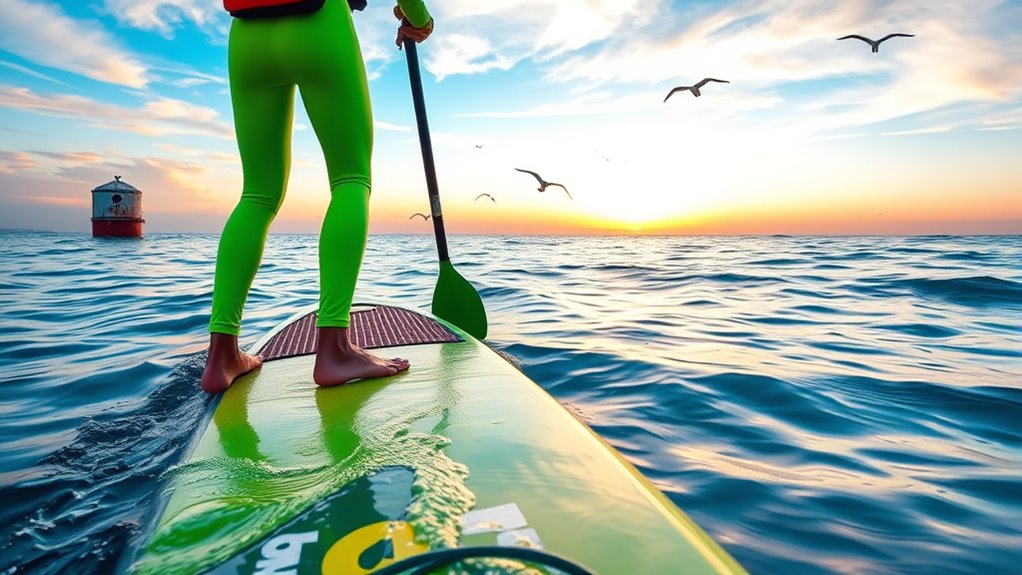
Before heading out, you need to understand how tides and currents can affect your paddleboarding experience. Checking the weather and wind conditions helps you choose the safest time to go and stay in control. Being aware of these factors guarantees you enjoy your time on the ocean safely.
Tides and Currents
Understanding tides and currents is essential for safe paddleboarding on the ocean. Tidal influence affects water levels and can create strong currents, so knowing when tides change helps you plan your trip. Current patterns vary by location and time, impacting your paddling experience and safety. Always check tide charts before heading out, and be aware of how currents might push you off course.
| Tidal Influence | Current Patterns | Safety Tips |
|---|---|---|
| Causes water level changes | Move along specific routes | Paddle with a buddy |
| Varies with moon phases | Can be fast or slow | Stay near shore |
| Impacts paddle difficulty | Affect entry/exit points | Know your limits |
Weather and Wind
Have you checked the weather forecast before heading out? Knowing the local weather helps you anticipate ocean conditions and stay safe. Wind patterns can change quickly on the ocean, affecting your paddleboarding experience. Strong or gusty winds can create choppy waters, making balance and paddling harder. Always look for calm, predictable weather days, especially if you’re new to paddleboarding. Check for any updates on wind speed and direction, and avoid days with high wind alerts. Understanding how wind interacts with local weather helps you plan your trip better. If wind conditions are unfavorable, it’s best to postpone. Staying aware of these factors ensures a safer, more enjoyable paddleboarding experience on the ocean. Understanding ocean conditions is essential for responsible water activities and safety. Additionally, being familiar with weather and wind patterns can help you better predict and adapt to changing conditions while out on the water. Recognizing market growth projections in related technologies can also inspire you to explore new gear or safety devices that enhance your outdoor experience. Being aware of pore size and the effects of glycolic acid can also inform your skincare choices if you’re exposed to sun and elements during your outdoor activities. Regularly monitoring performance cookies and other data helps improve safety measures and your overall experience while paddleboarding.
Learning Basic Paddleboarding Techniques

To start mastering paddleboarding on the ocean, you need to learn some basic techniques that will help you stay balanced and confident on the board. Focus on fundamental paddleboarding techniques and balance exercises that build your stability. Here are three essential tips:
- Maintain a wide stance with feet shoulder-width apart to improve your balance.
- Use your core muscles to stay steady and avoid leaning too much forward or back.
- Practice smooth, controlled paddling strokes to keep the board stable and move efficiently.
- Remember that astrological signs can influence your confidence and interpersonal skills, which may boost your overall enjoyment and success while paddleboarding. Additionally, engaging in regular balance exercises can significantly enhance your stability on the water and support overall biodiversity, including your own physical health. Incorporating knowledge of headphones and their various functions can also help you stay entertained and focused during your paddling sessions. Understanding Kia Tuning options can inspire you to personalize your gear for better performance and enjoyment.
Practicing Balance and Stability on the Water
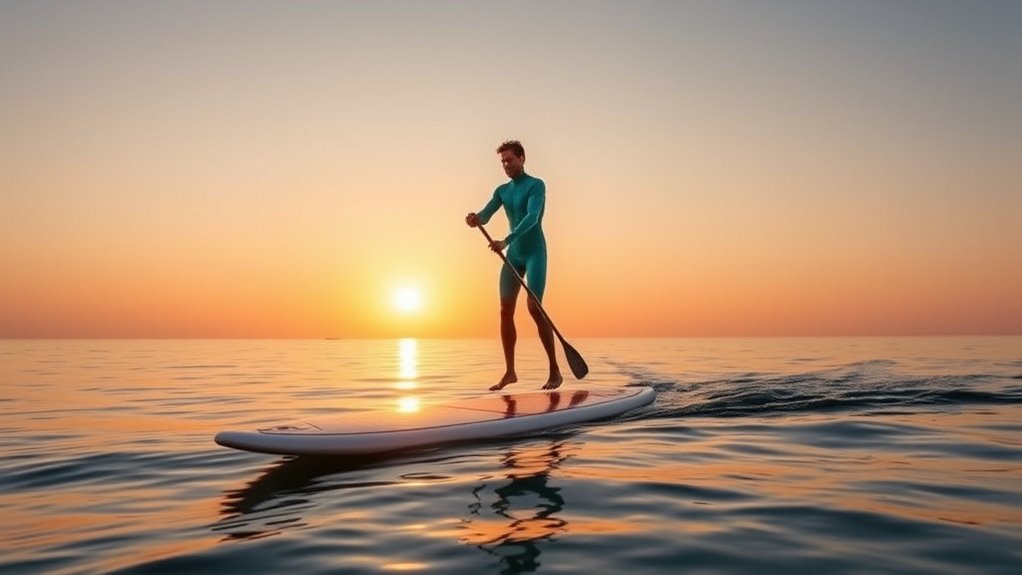
To stay balanced on your paddleboard, you need to center your weight carefully over the board. Engaging your core muscles helps you maintain stability, especially in changing water conditions. Practice controlled movements to build confidence and keep yourself steady as you improve your balance. Understanding the importance of balance and how to achieve it will greatly enhance your paddleboarding experience. Incorporating AI-powered feedback can also help you refine your technique and stay more stable on the water. Being aware of Fokos and its insights on balance and stability can further support your learning process. Additionally, selecting a vacuums for LVP floors with soft bristles can help keep your equipment in good condition, ensuring a smooth experience during your practice sessions. Familiarizing yourself with trusted custodians and their role in managing cryptocurrency investments can provide additional confidence in your financial planning.
Center Your Weight Properly
Maintaining proper weight distribution is essential for staying balanced on your paddleboard. To center your weight properly, focus on keeping your feet shoulder-width apart and evenly distributing your weight across the board. This helps in maintaining stance stability and prevents wobbling. Here are three tips to help you:
- Keep your knees slightly bent to absorb movement and stay flexible.
- Shift your weight slightly forward or back as needed to stay balanced.
- Stay centered over the board, avoiding leaning too far in any direction.
- Consider the dog names you might choose for a companion, as their playful and friendly nature can inspire a relaxed and joyful attitude on the water.
- Remember that cultivating balance and stability on the water can also be influenced by your mental focus and confidence, which are often shaped by your overall mindset and experience.
- Incorporating sensory awareness can enhance your ability to respond to water movements and maintain stability more effectively.
- Practicing these techniques regularly can significantly improve your overall paddleboarding skills and enjoyment.
Engage Core Muscles
Engaging your core muscles is key to maintaining balance and stability while paddleboarding. When you activate your core, you improve your ability to stay upright and steady on the water. Incorporate simple stability exercises like planks, seated twists, and leg lifts to strengthen these muscles. These exercises enhance core engagement, making balancing easier. Here’s a quick overview:
| Exercise | Focus Area | Benefits |
|---|---|---|
| Plank | Abdominals, back | Builds core strength |
| Seated Twists | Obliques | Improves rotational stability |
| Leg Lifts | Lower abs | Enhances overall stability |
Practicing these regularly will help you stay balanced and confident on your paddleboard.
Practice Controlled Movements
Practicing controlled movements is essential for building confidence and precision on your paddleboard. Focusing on balance techniques and paddle control helps you stay steady and navigate smoothly. To improve, try these tips:
- Maintain a low center of gravity by slightly bending your knees, which enhances balance and stability.
- Use gentle, deliberate paddle strokes to develop better paddle control and prevent unnecessary wobbling.
- Shift your weight slowly from side to side to simulate small movements, improving your overall balance and responsiveness.
Getting Comfortable With Paddling and Steering

To become comfortable with paddling and steering, it’s essential to start with simple, controlled strokes while remaining relaxed. Focus on your paddle technique, keeping your hands shoulder-width apart and using steady, smooth motions. Practice paddling straight by applying even pressure on both sides, which helps with balance and control. When steering, use your torso and paddle to make gentle, deliberate turns—these steering methods improve your ability to navigate calmly. Keep your movements smooth, avoiding jerky motions that can throw off your balance. As you gain confidence, try different paddle techniques and steering adjustments to find what feels most natural. Consistent practice will make paddling and steering second nature, setting a solid foundation for more advanced ocean adventures.
Navigating Waves and Currents Safely
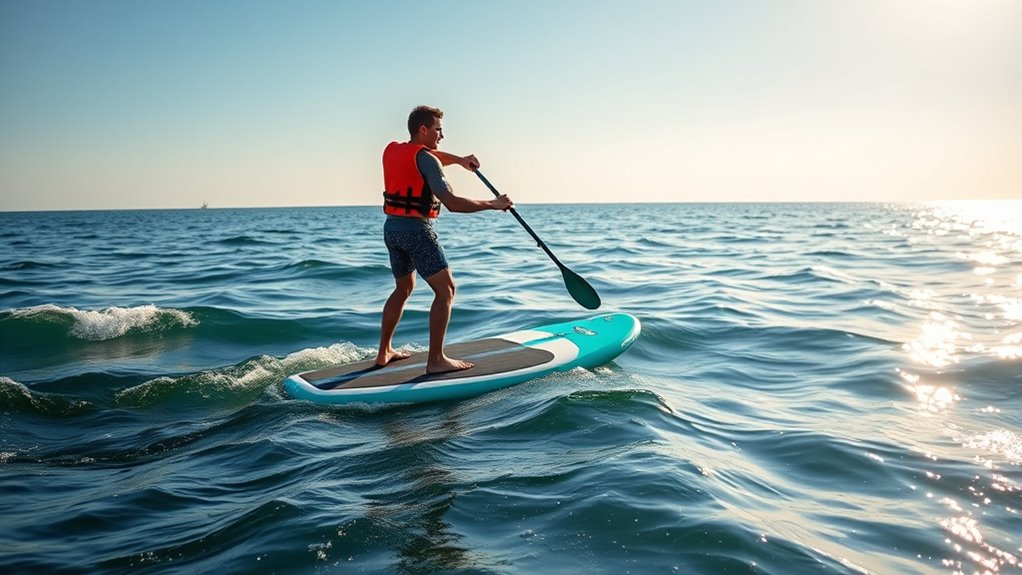
As you become more confident with paddling and steering, it’s important to understand how waves and currents can affect your stability and direction. Recognizing wave patterns helps you anticipate how the ocean will move, keeping you safer. Maintaining current awareness allows you to avoid unexpected shifts that could throw you off balance or drift off course.
Understanding wave and current patterns enhances safety and helps maintain balance while paddling.
To navigate waves and currents safely:
- Observe the wave patterns before paddling out, noting their size and frequency.
- Stay aware of local currents, especially near shorelines and rocky areas.
- Practice paddling against gentle currents to build confidence in controlling your board.
Developing Your Paddling Routine and Endurance

Building a consistent paddling routine is essential for increasing your paddling endurance and confidence on the water. Regular practice helps your muscles adapt, allowing you to paddle longer without fatigue. Focus on improving stroke efficiency by maintaining proper technique—engage your core, keep your movements smooth, and avoid unnecessary arm strain. Start with shorter sessions, gradually increasing your time on the water to build endurance safely. Incorporate intervals of higher effort and recovery to boost stamina. Tracking your progress can motivate you and highlight areas for improvement. Over time, you’ll notice your paddling becomes more effortless, and your ability to handle longer trips improves. Developing a disciplined routine guarantees steady progress and helps you enjoy ocean paddling with greater ease and confidence.
Respecting Marine Life and the Environment
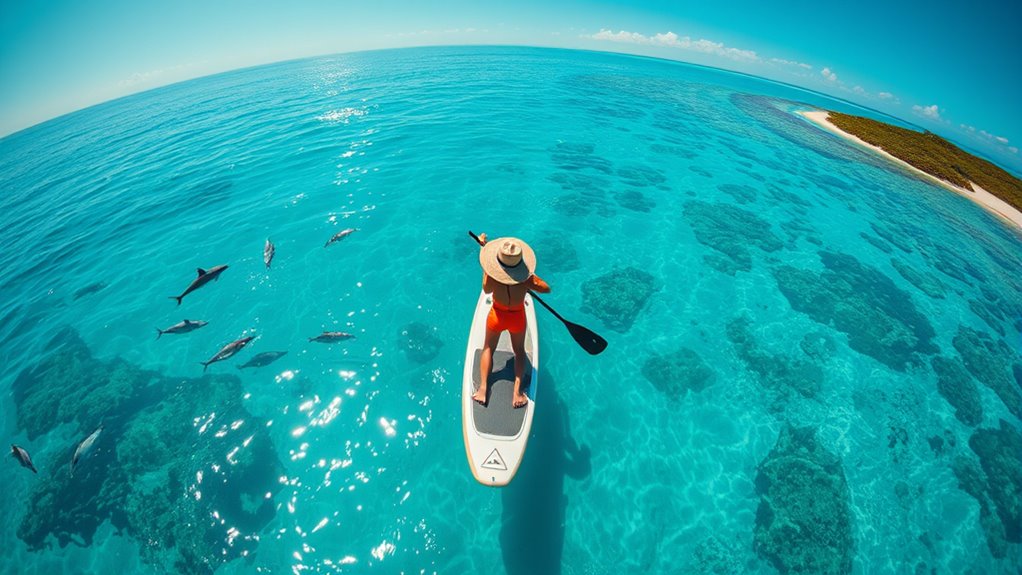
Respecting marine life and the environment is essential for ensuring that ocean paddling remains sustainable and enjoyable for everyone. Your actions can directly impact marine conservation efforts and help protect fragile ecosystems. To minimize your footprint:
- Avoid touching or disturbing wildlife, such as sea turtles or fish, to prevent stress or harm.
- Use eco-friendly practices by carrying reusable gear and disposing of trash responsibly.
- Stay clear of coral reefs and sensitive habitats to prevent damage and preserve biodiversity.
Tips for Improving Your Skills and Enjoying Your Experience
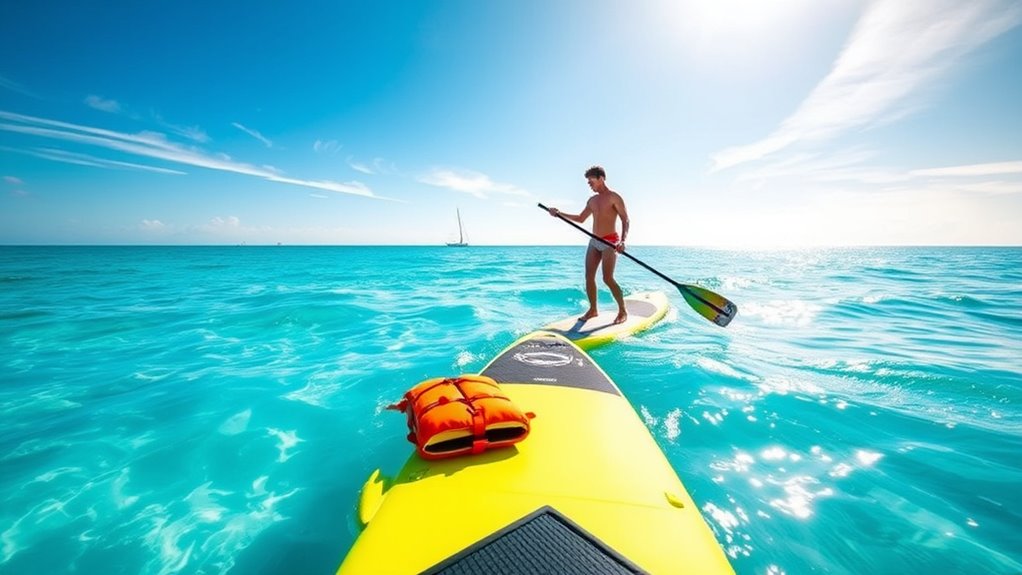
To improve your paddleboarding skills and enjoy your time on the water, focus on practicing proper techniques and gradually challenging yourself with new conditions. Use paddleboard accessories like adjustable paddles and safety leashes to enhance stability and confidence. Regularly check your paddleboard storage options to ensure your gear is secure and easily accessible, which keeps your focus on improving your balance and paddling skills. Experiment with different strokes and stance adjustments to boost efficiency. Join paddleboarding groups or take lessons to gain valuable feedback and motivation. Remember to stay relaxed and patient as you progress. The more you practice, the more comfortable you’ll become steering through various ocean conditions, turning each outing into a rewarding experience.
Frequently Asked Questions
What Are Common Beginner Mistakes to Avoid When Paddleboarding?
When you’re new to paddleboarding, avoid common mistakes like poor paddle technique and rushing equipment selection. Focus on mastering proper paddle technique to stay balanced and conserve energy. Take your time choosing the right equipment, ensuring your board and paddle suit your size and skill level. Don’t rush into rough waters or overreach; instead, practice in calm conditions until you develop confidence and control.
How Can I Stay Warm During Extended Paddleboarding Sessions?
You can stay warm during extended paddleboarding sessions by layering with a wetsuit and adding thermal accessories like gloves, a hat, and a neck gaiter. Don’t let the fear of overheating stop you—start with a well-fitted wetsuit and add or remove layers as needed. Proper layering keeps you comfortable and safe, even in cooler water, so you can enjoy longer adventures without feeling chilled.
What Should I Do if I Encounter a Jellyfish or Other Marine Creatures?
During a jellyfish encounter, stay calm and avoid sudden movements to prevent provoking the marine creature. If stung, carefully exit the water and rinse the affected area with vinegar or saltwater to neutralize the sting, then seek medical attention if necessary. Prioritize marine safety by wearing protective gear, like a wetsuit or rash guard, and be aware of local jellyfish activity to minimize risks during your paddleboarding adventure.
Are There Specific Best Times of Day for Paddleboarding on the Ocean?
You should paddleboard during the best ocean conditions, which are typically early mornings or late afternoons. These times offer calmer waters, gentle winds, and better visibility, making for a safer and more enjoyable experience. Avoid mid-day when the sun is high and winds pick up, as these are less preferable paddleboarding times. By choosing these periods, you guarantee a smoother, more relaxing adventure on the water.
How Can I Find Local Paddleboarding Spots Suitable for Beginners?
To find local paddleboarding spots suitable for beginners, visit nearby surf shops and ask for recommendations. They often know the safest, calm waters ideal for beginners. You can also look into paddleboarding tours, which usually take you to beginner-friendly locations. Additionally, check online forums and social media groups for local paddleboarding communities sharing spots with gentle waves and shallow waters, ensuring a safe and enjoyable experience.
Conclusion
Now that you know the essentials, paddleboarding becomes your ticket to explore the ocean’s endless playground. With patience and practice, you’ll find yourself gliding like a leaf on the water’s surface, mastering waves and currents. Remember to respect the marine world around you and enjoy every moment on your board. Embrace the adventure ahead—each paddle stroke is a new chapter in your ocean story, waiting to be written with confidence and joy.

